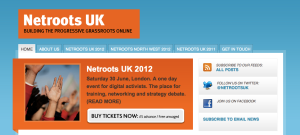I had a great time at Netroots UK yesterday, it was one of those conferences where various elements of my campaigning world came together, a conference full of NGO friends
 , Labour Party activists and lots of interesting people who I follow to help to collect ideas for this blog.
, Labour Party activists and lots of interesting people who I follow to help to collect ideas for this blog.
I’d strongly recommend that people go next year, and take some time to go back through the #NetrootsUK tag on twitter for a flavour of the discussion.
I came away with lots of reflections and a very long Evernote to go back and read, but here are 8 things that struck me immediately .
1 – We need to find self-replicating models for our campaigning. Paul Mason in a great overview of the UK campaigning sector described UK Uncut as a group that had changed the agenda.
Why? Because companies quickly became terrified of their branches being taken over, and that the model quickly grew from one action in London to many across the country, including involving many people who couldn’t immediately be identified as part of a radical movement.
Dani Paffard from UK Uncut on the same panel spoke on how they’d found the tactics they’d used to sustain media interest for much longer than they expected, and that it was a template that could easily be replicated.
2 – Training Matters– In the same seminar, Paul Mason identified on of the critical groups behind UK Uncut and the Occupy movement in the UK as those who’d attended and be trained at Climate Camp. They were he suggested ‘uber-activists + committed horizontalists who knew what to do’.
Adam Ramsay spoken of how many of those involved had been part of People and Planet as students and identified that as an important training ground, and suggested that while specific campaigns are like flowers that bloom from time to time, we need to invest in the roots that sustain them.
3 – We should be interested in who owns the internet – This wasn’t something that I’d spent much time thinking or indeed worrying about until last week, but hearing Sue Marsh from the Spartacus campaign speak about how they’d found blogs and chat rooms blocked during their campaigning on the impact of austerity on disabled people, you realise how important it is to make sure you have access to the tools you need to get out your message or organise your strategy.
4 – Parody Works – Jenny Ricks from Action Aid shared how they’d used parody to highlight the practices of Tesco and SAB Miller (makers of beer like Grolsch). Jenny suggested that parody has become much more popular because of the web, as it much easier to share and can be helpful in helping to shift a broader debate, in the case of Action Aid on tax dodging. She reminded us of the importance of ensuring significant research is available to back up the claims that are being made.
5 – That the fundamentals remain the same – In the closing session, we heard from Blue State Digital who used the examples of the It Gets Better and the Royal College of Nursing’s ‘Frontline First’ campaigns to remind us that campaigns:
- Need to make the most of moments.
- There is a thirst for personal connection even in digital campaigning.
- That relationships are long-term things to invest in.
- That online campaigning needs to drive offline activity.
6 – FoI is still a campaigning goldmine – Freedom of Information campaigner, Chris Coltrane reminded us of how easy at tool it is to use, and also that if you get told your request can’t be looked at because it costs too much money to always ask how they’ve made that calculation. My tips on using Freedom of Information are here.
7 – Presentation matters – The team from Who Funds You shared about their work looking at the transparency of UK think tanks, an important but potentially dry subject. However the front page of the site is a brilliant example of how to display the findings without hiding them in a press release. Karin Christiansen who’s behind the work also shared the following tips for anyone working on transparency issues suggested monitoring and ranking is the only way to get attention.
8 – We need to get out of our bubble – One of the final presenters, was Karina Brisby from the VOICE blogging project. She shared about how the project was set up to give voice to new people to share their perspectives on G20 and climate change summits, but also to ensure that the issues were communicated to those ‘outside the bubble’ by inviting bloggers to get involved who had diverse and different audiences.

 4- Absence – Many of the MEPs that we meet with remarked how much they valued hearing the views of civil society on this issue we were campaigning on as they’d already been lobbied by business groups. I heard one estimate
4- Absence – Many of the MEPs that we meet with remarked how much they valued hearing the views of civil society on this issue we were campaigning on as they’d already been lobbied by business groups. I heard one estimate 

